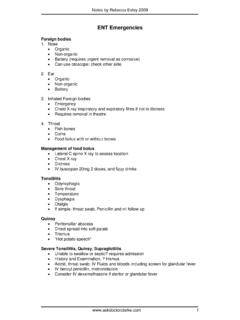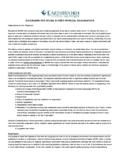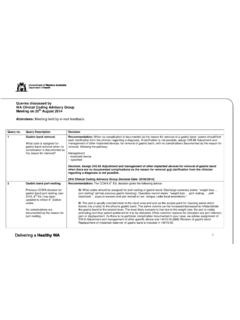Transcription of Deafness and Tinnitus Ear symptoms Hearing loss …
1 Notes on ENT Author Liz Tatman 1 Deafness and Tinnitus Ear symptoms Hearing loss otalgia Tinnitus vertigo Otorrhoea Deafness Causes: Conductive: o External ear - atresia, meatal obstruction wax, foreign body, infection. o Middle ear congenital anomaly, otitis media, cholesteatoma, ototsclerosis, neoplasia. Sensory neural: o Cochlear congenital, presbycusis, labyrinthitis, otosclerosis, Meniere s disease. o Retro-cochlear psychogenic, meningitis, MS, acoustic neuroma. Conductive Deafness sound doesn t reach cochlea, problems with middle or outer ear. Pure tone audiograms Subjective test of Hearing . Documents level at which patient can hear sounds of different frequencies normal is levels better than 25dB for 4 frequencies. Can test air or bone conduction (mask other ear). Symbols: Right ear 0 Left ear X Bone conduction right ear [ Bone conduction left ear ] Tympanometry Measure compliance of ear drum.
2 Calculate middle ear pressure (sound is transmitted best when pressures are equal). Normal graph has a peak. Fluid in middle ear gives flat line. Negative middle ear pressure shifts peak to left. Can show stapedius reflex dampens tympanic membrane with large sounds. This helps diagnose facial nerve lesions. Objective tests Electric response audiometry electrodes pick up response in CNS pathway. Otoacoustic emissions hair cells in cochlea produce sounds as part of transducing sound energy. These can be measured using a small microphone and averaging computer. This gives an indication of cochlear function to screen Hearing in young children. Startle response babies. Notes on ENT Author Liz Tatman 2 Tuning fork tests Use 512 Hz fork. Rinne s test: Compares bone and air conduction. Hold tuning fork in front of air then on mastoid process.
3 Air conduction should be better (Rinne positive). Better bone conduction implies conductive Deafness . False negative is when sound is heard by bone conduction in other ear (sensorineural Deafness ). Weber s test: Hold tuning fork on forehead. Normal is sound hear equally on both ears. With conductive Deafness localises to affected ear. With sensorineural Deafness localises to other ear. Tinnitus Related to Hearing loss of any cause but usually sensorineural. Can be extrinsic ( insects, vascular causes) or intrinsic (drugs, labyrinthitis, presycusis, Menieres disease, noise induced, otosclerosis, acoustic neuroma, epilepsy). If pulsatile suspect a vascular tumour close to ear (glomus tumour of paraganglionic cells of nerves around jugular bulb which may extend into middle ear). If unilateral must be investigated as may be acoustic neuroma.
4 Generally manage by reassurance. Can also use masking device, avoid aspirin and alcohol. Choleastoma Defect in migration of epithelium leads to sac of keratinising squamous epithelium. Usually in attic or epitympanic part of middle ear. Ear drum is retracted and migrating epithelium accumulates and becomes infected. Can erode bone and therefore damage nearby structures. Causes chronic, foul smelling discharge, conductive Hearing loss , attic retraction, attic aural polyp and complications (facial palsy, vertigo , intracranial sepsis). Rarely congenital, mostly acquired. Treat by surgical removal. Glue ear Sterile effusion in middle ear (also secretory otitits media). Poor ventilation of middle ear leads to accumulation of thick sticky effusion, which causes Hearing loss and can predispose to infection. Can be due to acute otitits media, Eustachian tube dysfunction, nasopharyngeal tumour.
5 Very common in children but normally resolves spontaneously. If not treat by grommet insertion allow middle ear ventilation. Appearance on otoscopy dullness, radial blood vessels, more horizontal malleus handle, absent light reflex. Notes on ENT Author Liz Tatman 3 Otosclerosis Disease of bony labyrinth hard compact bone is replaced by spongy bone. Usually have a family history. Causes Hearing loss due to: Toxin production affecting cochlear. Fixation of stapes foot plate and conductive Hearing loss . Consider if progressive conductive Hearing loss with normal ear drum, often starts in pregnancy. Can replace fixed stapes with piston if severe. Sensorineural Deafness Inner ear damage due to: Congenital damage due to anoxia. Degenerative presbycusis ( Hearing loss at higher frequencies), Menieres disease (episodic Hearing loss especially low frequencies, Tinnitus and vertigo ).
6 Labyrinthitis vertigo . Acoustic trauma acute or chronic (noise induced Hearing loss is generally in a narrow frequency range). Drug ototoxicity aminoglycosides, frusemide. Ear wax Can block EAM causing conductive Deafness . Wax softening agents oil or sodium bicarbonate may help. Syringing can remove wax if no perforations, grommets or ear infection. Involves washing out wax with warm water squirt back along top of ear canal. Otoscopy Handle of malleus, pars flaccida, pars tensa, light reflex in anteroinferior quadrant (as concave shaped). Membrane should normally be pearly grey and slightly tranluscent. Otitis media hyperaemia of eardrum, then loss dull and may bulge. Glue ear concave dull drum, superficial radial vessels Notes on ENT Author Liz Tatman 4 Ear Infections Anatomy of the ear External ear: Pinna or auricle and external auditory meatus.
7 Transmits sound to tympanic membrane. Auricle develops from 6 nodules, consists of elastic cartilage covered in skin. Auricle has named folds = Darwin s tubercle, antihelical fold, helical fold, tragus, antitragus, lobule. External auditory meatus outer third is cartilaginous with sebaceous and wax (not mucus) glands and hairs, inner two thirds are bony. Complex nerve supply auricolotemporal branch of trigeminal (anterior), greater auricular (posterior), also glossopharyngeal and vagus (so examination of ear can cause coughing). This means that otalgia may be due to referred pain from many structures (TMJ, parotid, sinuses, teeth, tongue, tonsil, C spine, pharynx, larynx), especially carcinoma of pyriform fossa. Skin is migratory and travels outwards so ears are self cleaning. Wax is bacteriostatic.
8 Middle ear: Air filled space in petrous temporal bone. Transmit and amplify (tympanic membrane is larger than oval window, ossicles act as levers) sound to fluid in inner air. Connected with mastoid air cells (via antrum). Eustachian tube communicates with nasopharynx (part bony, part cartilagionous). Needed to allow oxygen to mucosa, equalise air pressures so tympanic membrane can vibrate and drain secretions. Tympanic membrane forms lateral border external squamous epithelium, middle fibrous, inner layer continuous with middle ear mucosa. Epitympanum above and hypotypanum below. 3 ossicles malleus, incus, stapes (footplate on oval window so sets up fluid pressure wave to stimulate cochlea). Medial wall opens to inner ear via round and oval windows, basal turn of cochlear forms a bulge (promontory).
9 Facial nerve runs across medial wall in bony channel. Inner ear: Membranous and bony labyrinth in petrous part of temporal bone. Membranous labyrinth, filled with endolymph cochlea, vestibular system (saccule, utricle, semicircular canals). Surrounded by perilymph (like CSF). Hear by organ of Corti on basial membrane or cochlea. Hair cells are linked to tectorial membrane. Notes on ENT Author Liz Tatman 5 Otitis externa Common. Generalised inflammation of skin of EAM tender, swollen, narrowed EAM. Causes eczema, psoriasis, trauma, local infection (pseudomona, staphylococcus, candida, viral). Generally a combination water causes eczematous response, itching leads to scratching causing local trauma, infection can enter etc. symptoms otorrhoea, Hearing loss , pain, itching. External ear canal does not have mucous glands so if mucinous discharge must have perforation and underlying middle ear problem.
10 Treatment Aural toilet (suction and microscope or dry mopping) Local medication (antibiotic, steroid, antifuncal, glycerin and ichthammol) as drops or wick. May lead to perichondritis or facial cellulitis. Malignant otitis externa - severe pseudomonas infection which spreads to bone causing osteomyelitis of skull base. Causes severe pain and cranial nerve palsies. Otitis media Inflammation of the middle ear leads to formation of an effusion either sterile (glue ear) or suppurative (infection). Pressure build up stretches eardrum and causes pain. The drum then perforates causing otorrhoea. Acute otitis media: Usually children following URTI, which spreads via Eustachian tube. symptoms Hearing loss , pain, otorrhoea, pyrexia, systemic upset. Can become a recurring problem if glue becomes reinfected. Grommets also drainage.












